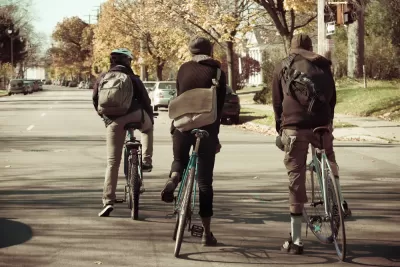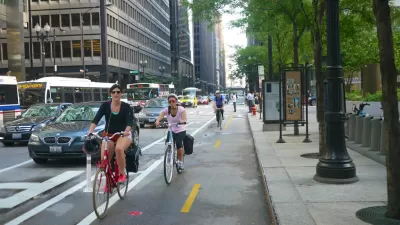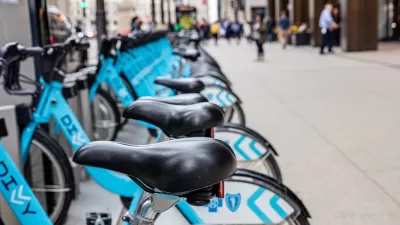Recent research suggests that cyclists of color are more likely to receive citations, but enforcement has little correlation with improved safety.

A new study from Jesus M. Barajas assesses the disproportionate impact of cycling citations on Black and brown communities in Chicago. Some important conclusions: "Tickets were issued 8 times more often per capita in majority Black tracts and 3 times more often in majority Latino tracts compared to majority white tracts. More tickets were issued on major streets, but up to 85% fewer were issued when those streets had bike facilities, which were less prevalent in Black and Latino neighborhoods."
"The high number of tickets in majority Black neighborhoods came despite having the fewest serious bicycle crashes." However, Black neighborhoods "had the highest number of serious crashes of all modes on average," in part due to having "higher shares of streets without bicycle infrastructure compared to majority Asian or white census tracts."
A spatial analysis of tickets suggests that "bicycle tickets are only weakly associated with safety needs, if at all." The study also shows that improved bike infrastructure could reduce citations. "Separated lanes appeared to have the strongest effects. On arterial streets, cyclists received citations 25% as often when there was a separated lane compared to no bicycle infrastructure."
Barajas concludes that "[r]emoving inequities in cycling infrastructure provision, while also ensuring communities are fully represented in bicycle planning processes, is crucial" to any cycling safety strategy.
FULL STORY: Biking where Black: Connecting transportation planning and infrastructure to disproportionate policing

Trump Administration Could Effectively End Housing Voucher Program
Federal officials are eyeing major cuts to the Section 8 program that helps millions of low-income households pay rent.

Planetizen Federal Action Tracker
A weekly monitor of how Trump’s orders and actions are impacting planners and planning in America.

Ken Jennings Launches Transit Web Series
The Jeopardy champ wants you to ride public transit.

Washington Legislature Passes Rent Increase Cap
A bill that caps rent increases at 7 percent plus inflation is headed to the governor’s desk.

From Planning to Action: How LA County Is Rethinking Climate Resilience
Chief Sustainability Officer Rita Kampalath outlines the County’s shift from planning to implementation in its climate resilience efforts, emphasizing cross-departmental coordination, updated recovery strategies, and the need for flexible funding.

New Mexico Aging Department Commits to Helping Seniors Age ‘In Place’ and ‘Autonomously’ in New Draft Plan
As New Mexico’s population of seniors continues to grow, the state’s aging department is proposing expanded initiatives to help seniors maintain their autonomy while also supporting family caregivers.
Urban Design for Planners 1: Software Tools
This six-course series explores essential urban design concepts using open source software and equips planners with the tools they need to participate fully in the urban design process.
Planning for Universal Design
Learn the tools for implementing Universal Design in planning regulations.
Heyer Gruel & Associates PA
Ada County Highway District
Institute for Housing and Urban Development Studies (IHS)
City of Grandview
Harvard GSD Executive Education
Toledo-Lucas County Plan Commissions
Salt Lake City
NYU Wagner Graduate School of Public Service





























